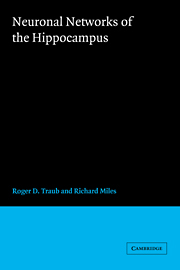Book contents
- Frontmatter
- Contents
- Acknowledgments
- Prologue
- 1 The hippocampus in context
- 2 Physiology of single neurons: voltage- and ligand-gated ionic channels
- 3 Synaptic function and organization of the CA3 region
- 4 The single-cell model
- 5 Model of the CA3 network
- 6 Collective behaviors of the CA3 network: experiment and model
- 7 Collective behaviors of the CA3 network: spontaneous oscillations and synchronized synaptic potentials
- 8 Field effects
- 9 Theoretical approaches: mathematical neural networks
- Conclusion
- Notes
- References
- Index
8 - Field effects
Published online by Cambridge University Press: 05 February 2012
- Frontmatter
- Contents
- Acknowledgments
- Prologue
- 1 The hippocampus in context
- 2 Physiology of single neurons: voltage- and ligand-gated ionic channels
- 3 Synaptic function and organization of the CA3 region
- 4 The single-cell model
- 5 Model of the CA3 network
- 6 Collective behaviors of the CA3 network: experiment and model
- 7 Collective behaviors of the CA3 network: spontaneous oscillations and synchronized synaptic potentials
- 8 Field effects
- 9 Theoretical approaches: mathematical neural networks
- Conclusion
- Notes
- References
- Index
Summary
Thus far, we have concentrated on collective neuronal behaviors in which the only interactions have been mediated by chemical synapses. Another type of neuronal interaction is clearly of importance during hyperexcitable states and may exert at least subtle influences even under normal conditions. Influences between neurons may be mediated by the flow of transmembrane current through the extracellular medium: field effects (Dudek and Traub, 1989). Field effects provide a means for the synchronization of action potentials in different neurons on a time scale of about 1 ms. Slow or DC extracellular fields can also bias a large population of neurons, rendering them all more excitable. The general subject of electrical field effects in the brain has been reviewed by Faber and Korn (1989). We shall restrict our attention here to the hippocampus.
There are several structural features and electrophysiological observations suggesting that field effects might be important in the hippocampus. First, there is the large amplitude of extracellular population spikes that can be obtained after synchronized stimulation of an afferent pathway. Amplitudes of 5–10 mV or more are not unusual in the stratum pyramidale during epileptiform activity in vitro, and population spikes of 20 mV and more in vivo are not unusual (Somjen et al., 1985). These extracellular negative potentials would be expected to produce transmembrane positivities.
- Type
- Chapter
- Information
- Neuronal Networks of the Hippocampus , pp. 194 - 203Publisher: Cambridge University PressPrint publication year: 1991



